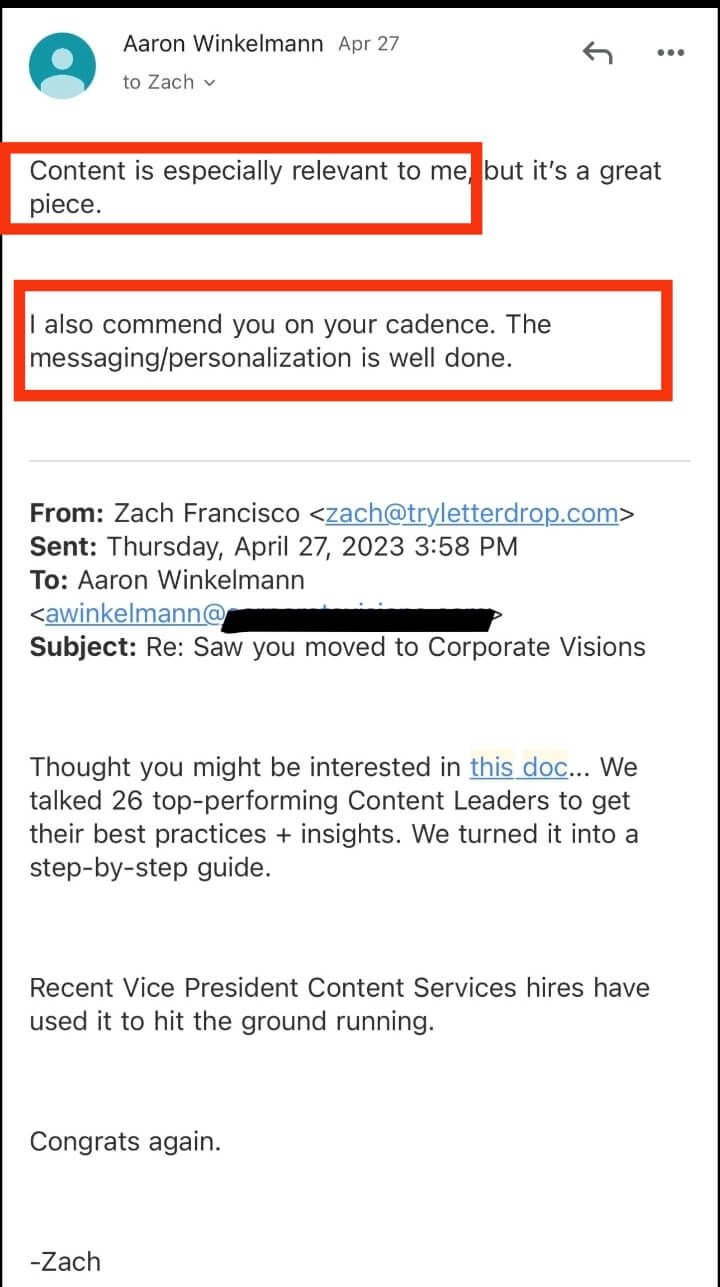B2B marketers love emails. It is their top revenue generator. 64% of marketers say email marketing was responsible for meeting business goals.
But there's a catch. The emails have to be relevant and at the right pace. In other words, have the right cadence.
Here's an example.

Zach Francisco, sales lead at Letterdrop, sent Aaron Winkelmann, VP of Content at Corporate Visions, a series of cold emails. The campaign was a success.
What stood out?
The messaging, personalization, and cadence.
What exactly is an email cadence?
Email cadence is more than how often you send an email. It is the frequency, timing, content, and audience of an email campaign.
Let's go through some common email cadences below. 👇
Nurturing users during a free trial
Often, free trials last a week or two, so there's no time to waste. Begin with an introductory tutorial. Follow up with emails showcasing your product's popular features. As the trial period ends, guide them on how to upgrade.
CopyAI’s free trial onboarding emails are a good example.
Their welcome email shared valuable tips on getting the most out of the product.

Next, an email with instructions on how to use the app's most popular features.
After two weeks, an email requesting feedback.
Keeping users engaged after a sale
Keeping your customers engaged is key to renewals and upsells. But don’t overwhelm them. Instead, space out valuable resources, guides, tutorials, and case studies.
Segment customers based on usage patterns. Then target those who might need additional licenses or specific add-on features. Send specific emails to those groups highlighting the benefits of an upsell.
Before the end of the subscription, offer incentives to encourage renewals or upgrades.
Curating a cadence to appeal to different segments
Let’s say you provide cloud computing services to businesses. And you’re trying to reach two segments: IT managers and C-level executives.
IT Managers are cool with weekly updates and product offers. They want to stay up-to-date with new tech trends and solutions.
C-level executives are busy and prefer high-level content. So it makes sense to adopt a monthly newsletter with industry insights, case studies, and executive summaries.
How to Find the Right Email Cadence for Your Campaign
1. Set clear email marketing goals
First, define your goals for the email campaign. Increase sales? Promote a new product? Nurture leads? Or thought leadership? Be clear about it. Match email campaign goals with overall business and marketing goals. Set KPIs to measure CTRs and track conversions.
If your goal is to establish thought leadership, this means high-level weekly or monthly emails with original research or expert POVs. Of course, it won't be like a daily welcome email drip campaign.
2. Set Up a preference center
Let customers choose the type of emails they want to receive and how often. If you offer a variety of emails, such as monthly roundups, promotional emails, weekly industry news, and so on. Let customers choose which emails they want to receive and how frequently. You can include all of these options in your preference center.
Also, keep an email preferences link in the footer of each email. So subscribers can make changes whenever they wish. Rather than unsubscribing completely, they will be able to manage their preferences.
3. Segment Users
The most successful email campaigns segment subscribers and personalize messages. In fact, marketers say that personalized and segmented email campaigns have led to a 760% rise in email sales.
Customer Segments to Consider:
- Engaged Fans
Loyal subscribers. They open, click, and interact with your emails regularly. Some might have seen your content elsewhere or bought from you before.
Send them personalized thank-you emails for their support. You can also give rewards or early access to new products or features.
- Potential Customers
Leads who've shown interest in your offerings but haven't converted. They might have signed up for newsletters, downloaded resources, or attended webinars.
Focus on nurturing this segment. You can send targeted discounts, product information, and case studies depending on interests.
- Inactive Subscribers
Try a re-engagement email campaign. Personalize based on previous interactions or purchases. Tailor the email content to match their specific interests and pain points. Test different subject lines and timing to optimize engagement. Send a farewell email if there's still no response.
4. Collect Customer Feedback
The best way to get customer data is to ask short, insightful questions instead of making it look like a chore. You can even use thumbs up and thumbs down emojis in some cases.
Make the process easy and enjoyable for your customers by following these tips:
- Keep it short and sweet. Long surveys can be intimidating. Stick with concise and engaging questions that are easy to answer.
Example: "How satisfied are you with our recent product update?
- Ask questions that match your goals.
Example: "How likely are you to recommend our services to a friend or colleague?
- Encourage customers to share their thoughts and provide valuable feedback with open-ended questions.
Example: "Please share any additional comments or suggestions to help us improve our services."
- Address customers by their names and make the experience feel personalized.
Example: "Hi [Customer's Name], How’s it going?"
Wrapping up
Your campaign's success depends on paying attention to your subscribers and adapting the right cadence. Get it right, and you'll see a spike in click-through, and conversion rates. Keep testing and updating as your business grows and your customers' needs change.


